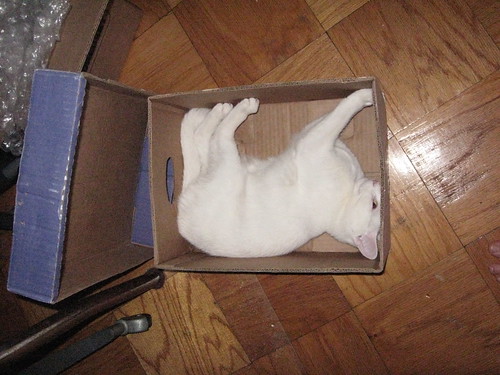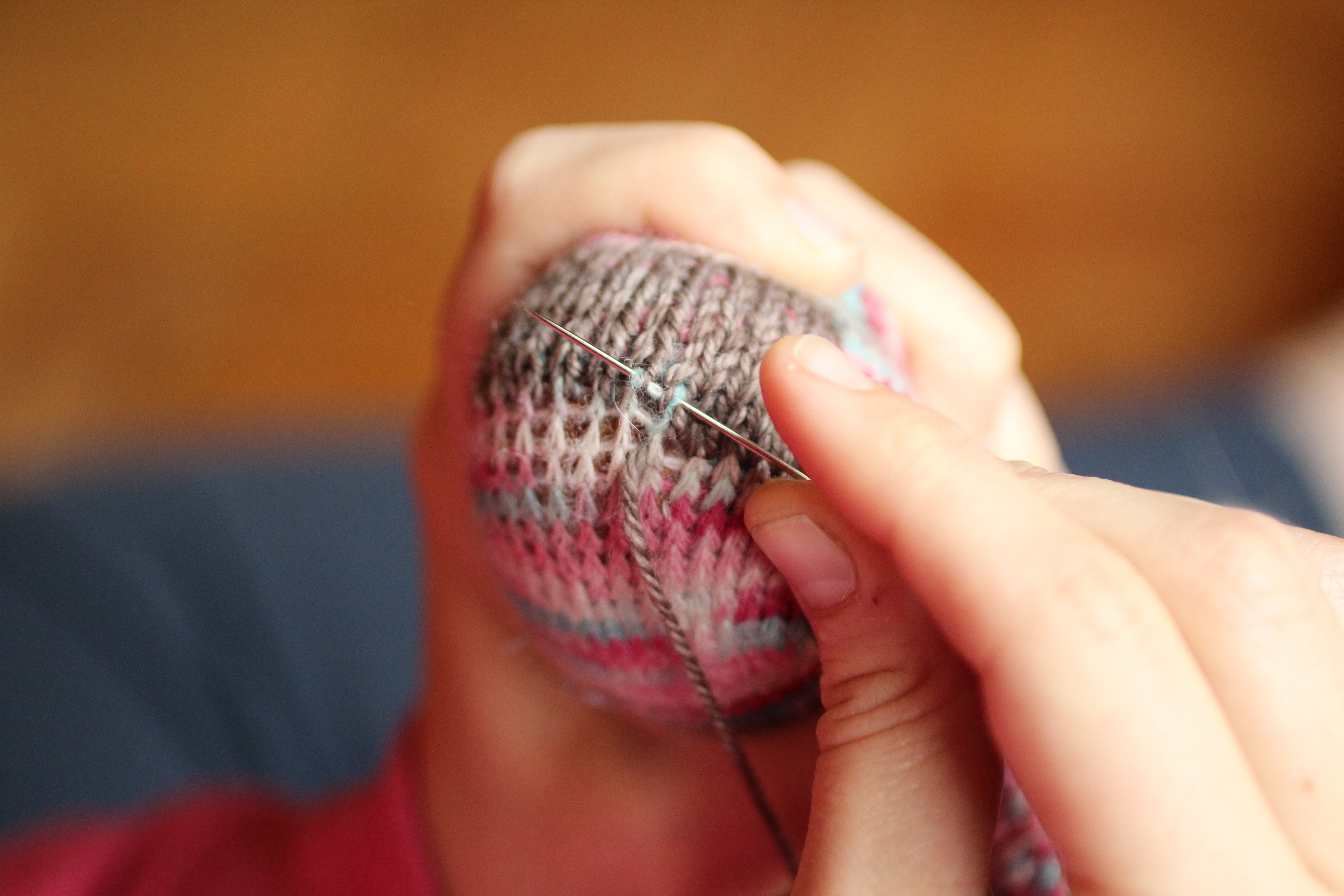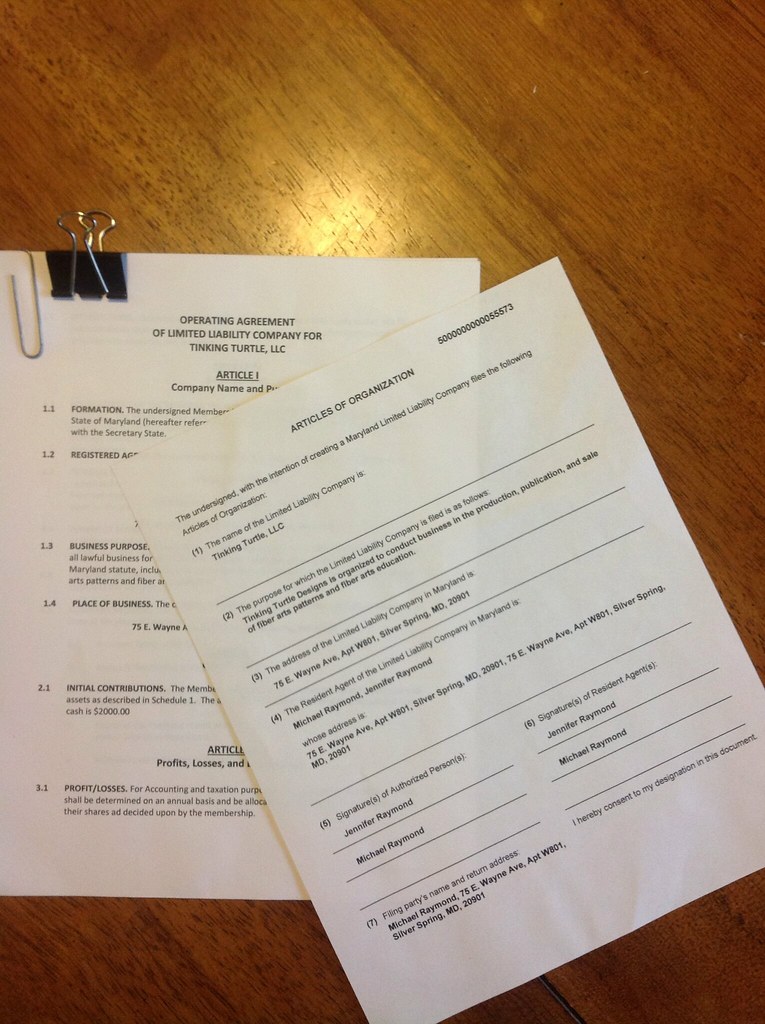I feel bad that I post more pictures of Watson, but Peake just doesn’t seem to get himself in the same scrapes as Watson does. Or maybe it’s that Peake just doesn’t hold still for me to capture them.
The Benefits of Doing Something Yourself
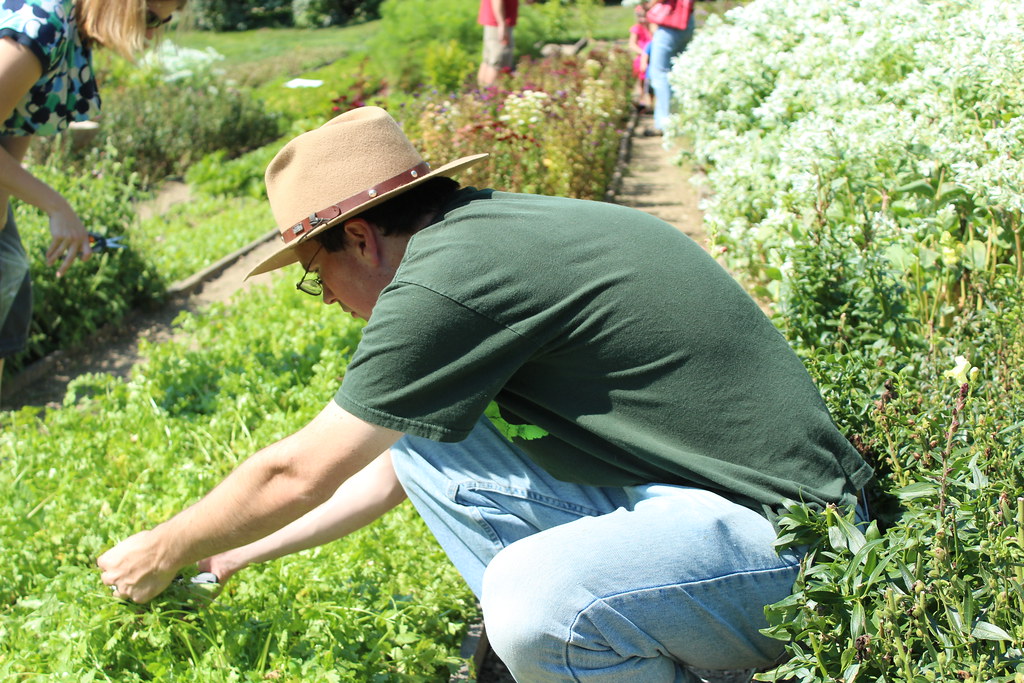 |
| Picking herbs at an open farm day at our farm share, Spiral Path Farms. |
Michael and I have promised ourselves that this is the last week of apple processing. Really. We’d promised ourselves that it was going to be the last 2 weeks ago, but I was tempted by a crate of apples for $25 (it worked out to be less than $1 per lb, which is a great price in these parts!) and have been drying apples for camping and snacking. Michael on the other hand found a few coworkers who wanted to buy apple butter off of him, and Michael was only too willing to sell jars to them. So he, also, is replenishing the stock of canned things. At the end of this, we will have processed more than 150 lbs of apples… quite frankly, it probably was more. And after we finish the apples? We’re going to try our hand at cheese and yogurt.
A couple of our friends have questioned our sanity, spending so much time canning and preserving when things are much cheaper and less time-consuming if you buy them at the grocery store. However, when I talk about canning and such with knitters and crocheters, I receive far less of that attitude. I think knitters and crocheters “get it” far more than others. Why? Because we all see the benefits to doing things ourselves. So for those of you stumped by the stitchers, canners, or other DIY people out there, here’s a list of reasons why we love taking the time to do it ourselves.
 |
| Our apple peeler, slicer and corer. I love it. |
- You know what is in it. When you are canning fruits and vegetables, you have control of every little thing you put in the jar. It can be exactly the way you want it. The same thing with knitting and crocheting. You have control over the yarn and it’s contents, the pattern, fit, style and feel of the fabric. Either way, you can make intentional choices about what goes into the final product.
- You know where it’s come from. In the same way you have control over what you create, you have control over the object’s origins. For food, that means I can choose the freshest, best ingredients. If I want organic, I can procure organic food. If you make your own sweater, you can choose what yarn you want, and you can make informed choices about how it is sourced. Since you are the one making the garment, you know it was made in ethical conditions. If you want to support the local economy, you can choose yarn that is made entirely in the United States (Like Shepherd’s Wool) or a local dyer (like Dragonfly Fibers, for me).
- I find a meditative quality to making my own things. The repetition of stitch stacking upon stitch. The motion as I crank applesauce through our food mill. There is a thoughtfulness and deliberateness to doing the same thing over and over, where it acquires more meaning because there’s more thought and deliberation put into each step. Or maybe it’s just me. I’ve always liked repetitive tasks.
- There’s satisfaction in doing something yourself. On our fridge, we have a magnet that reads, “I eat Local, because I CAN.” It’s both a reminder and a boast. We eat local, because we can and preserve. We also eat local because we are fortunate enough to have access to local produce. Either way, it’s a boast, because when it comes down to it, there’s something really satisfying when you pop open the top to something you canned yourself and you make a meal out it. I get the same feeling when I knit or crochet. There’s something incredibly satisfying about having someone compliment something you made and being able to say, “Thank you. I made it.” The socks that I made myself are warmer, even if it’s only my imagination. The food that I can myself is tastier, even if it’s just because I remember making it.
Plaited Hat in Interweave Crochet Accessories
Published in: Interweave Crochet, Accessories 2014
Craft: Crochet
Category: Hat → Beanie, Toque
Published: October 2013
Yarns suggested: South West Trading Company Therapi
Yarn weight: Worsted / 10 ply (9 wpi) Information on yarn weights
Gauge: 15 stitches and 8.5 rows = 4 inches in dc
Hook size: 4.0 mm (G)
Yardage: 440 yards (402 m)
Sizes available: Finished Size 14 (16, 18, 19, 20, 21, 22, 23, 24)” head circumference to fit child’s XS (S, M, L, XL), adult
(S, M, L, XL). Sample shown in 22″. Hat is meant to be worn with 1–2″ negative ease.
I’m over at Jordana’s Today – Dipping my toe into runway fashion.

In addition to some analysis of the runway, I highlight a fun and easy crochet stitch – the wave stitch. Give it a try!
Rainy Weekend Activity – Darning Socks
Like most of the East Coast, this past weekend was a rainy drizzly grey one. I bravely left the apartment for teaching classes, but in the evening I snuggled into the couch with my really ugly slippers, a blanket, tea and one of my two current projects. I’m working a technique that I’m hoping to turn into a design proposal, so I can’t show pictures of that right now. The other thing I was working on was repairing a pair of socks.
Duct Tape Dress Forms at Woolwinders
I’ve taught my Duct Tape Dress Forms class a couple of times before. Actually, I’ve taught it enough times that I’ve lost count. You’d think after teaching it a bunch of times it’d get predictable – and in some ways you’d be right. I have a much better sense of how the class works as far as timing, and I can predict a little bit better the questions people ask.
BUT, each time I do the class I end up laughing, surprised and delighted by the stories and antics my students get into. There’s something about being wrapped in ductape, learning about your body and how best to make adjustments for it, that just gets people to open up. By the end of the class people leave tuckered out and smiling. I love that.
I’ll leave you with some pictures from the class:
4 Quick Exercises to Draw Inspiration From Nature
 |
| Credit: Chimney Corners Camp |
I’ve mentioned before that Fall is my favorite season. The apartment smells like apples for the third week in a row (the applesauce is done, the apple butter and apple pie filling. We’ve moved on to dry apples). I’ve pulled out my comfy sweatshirts and my slippers. I’ve moved away from socks (my go-to summer knitting) to a snugly rug for in front of my bathroom. And every day as I go for a walk or travel to and fro, I stop and look at the leaves to see the color gradually change (I can’t help feel competitive; the camp where I grew up is already in a glory of color).
For me, I see echos of nature wherever I go, and they come to roost in the back of my brain, to slip out weeks or months later when a design call has need. But sometimes it’s fun to do different things to get yourself inspired about nature. Below is a list of different exercises I sometimes use when working on a design call.
- Capturing lines: go for a walk with a camera or sketchbook. Get really close to things and

by PictureWendy sketch them. Use only the most basic lines. I love looking at butterfly wings, veins in leaves, whorls in seashells or patterns in broccoli. Could you replicate those patterns or lines with stitches?
- Unexpected color: I love going to the farmer’s market and finding unexpected color combinations. Go to the zoo or hop on pinterest. What colors does nature throw together that are unexpected or stunning? Try pairing green with practically anything. Flowers in all colors pair well with green. Try to replicate that in your own colorwork.
- Touchable texture: there are so many different textures you can encounter in the great big world! Find something nubby, bumpy or three-dimensional. How would you capture that in knit or crochet? What would you do?

by klugi - Fractals or repeating patterns: I love going on pinterest and finding cool or interesting patterns. There are so many repeating patterns in the water, in the air, or represented in flowers. Could you take that pattern and put it on a hat, shawl or other creation? What about the radiating lines of a palm leaf – would you capture that in intarsia, stranded knitting, or Irish Crochet? What about the interwoven patterns of exposed roots or rock – is that cablework, knotwork, or something else entirely?
So you want to work for yourself: Now What?
From the Business Desk
Welcome to the first edition of a semi-regular series that I will be contributing to this site focusing on the business side of running a small fiber arts business. As introduced in the first post I wrote earlier this week, I officially
joined the Tinking Turtle team back in August to take on management of the business side of the organization: contract management, accounting and bookkeeping, and strategic/structural planning. I plan on writing monthly topics discussing some of the trials, tribulations, and learning experiences that have come about in the past three plus years as a small business.
For my first topic, I wanted to open the door with an overview of small business organization, as for many business owners, this is the first consideration after making the plunge and deciding you want to start being your own boss.
The most significant difference that a business owner should understand among all levels of organization is that there is a trade off between operational flexibility and protection from risk. As a business owner, this is accomplished by either legally separating your business and yourself into two separate entities, to reduce your individual liability and risk in the event of an issue, or by having you and the business be one and the same to maximize your flexibility and minimize your reporting requirements.
The IRS has a great overview site to discuss how different organizational structures are affected by taxation and reporting requirements. Additionally, a wonderful resource for the crafty type person to begin to explore what option would be best for you is The Craft Artist’s Legal Guide, presented by NOLO.
Please note that the below information is presented as advice only. If you are considering any of these specific options, it is highly recommended that you consult with an accountant or attorney to understand any additional legal ramifications of your decision.
The core business structures a small business would be considering fall into three primary groups: Sole Proprietorships, Partnerships, and Corporations of various types. Sole Proprietorship and Partnerships are considered unincorporated types of business, while the various type of Corporation, explained below, are all incorporated, which means they are legal entities filed within the state of primary operations of the business.
There are no requirements to being operating your business as a Sole Proprietorship at the macro level (certain municipalities may require business licenses, be sure to check with your local licensing board first!); once you start operations, you are operating under this structure. With the Sole Proprietorship, your only structural requirements are to file additional forms with your income tax on an annual basis. The drawback of this level of organization is that there is limited protection from risk as a Sole Proprietor, so you personally can be held accountable for the debts and tax liability of your business.
Partnerships are similar to Sole Proprietorship in that they require little formal reporting outside of an annual report to the IRS. Partnerships are strongly recommended to prepare a formal agreement, to codify some of the responsibilities or distributions, especially if it is not an even split between the applicable parties. Partnerships additionally do not limit individual liability, and in the event of a dispute, all partners and their assets are considered fair game.
The most formal level of organization for a small business is one of many types of Corporations. There are three specific types, all of which exist as stand-alone entities, separate from the business owners: the S Corporation (S-Corp), the C Corporation (C-Corp or what is traditionally referred to as a Corporation) and the Limited Liability Corporation (LLC). The largest difference between these different structures are how corporate taxes are handled; C-Corps are taxed as separate corporate entities with a separate tax governance and structure; S-Corps are what are considered “pass through” entities, where any tax burden is paid by the owners or shareholders. LLCs are a fairly new entity that are governed by state law, and can be organized in multiple ways, but that’s a topic for another post. Any of these forms of corporation are established by incorporating with the cognizant state authority, usually the Secretary of State.
No matter which structure you choose for your business, having a plan for how you want to establish yourself is key to being a successful business owner, and turn the craft hobby that you love into a viable profession.
How has the Shutdown Affected the Fiberarts in Metro DC?
Michael highlighted in his post the other day the effect the government shutdown of various offices has had on the fiberarts industry. Following that, I became interested in how the shutdown has affected various fiberarts businesses and the community at large. With things being so uncertain, I wondered, would people be shopping and knitting less? The stories I heard from DC area stores were surprising.
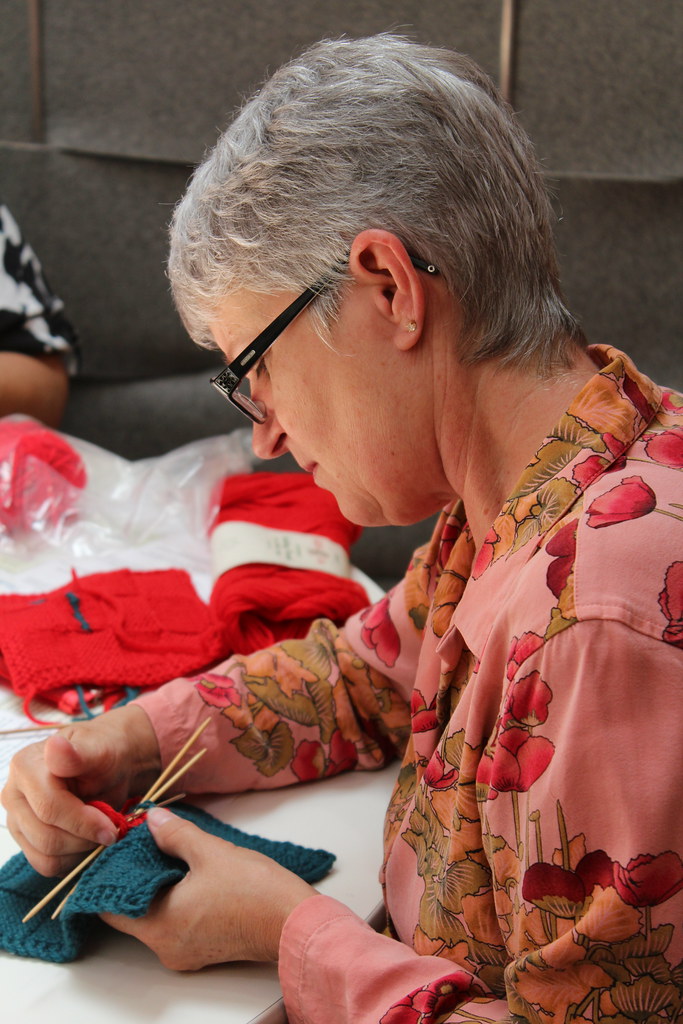 |
| Student at Fibre Space |
Fibre Space (in Old Town, Alexandria) has (and still is) offering free beginning knitting lessons to any government employee who comes in between the times of 1-5 pm at the store. Danielle, the owner, told me that there have been between 50 and 75 beginning students coming through the store each day – so much so that they had to recruit more teachers!
Fibre Space isn’t the only store that has been offering support to furloughed government workers. The Yarn Spot in Wheaton, MD, offered afternoon tea on Friday the 4th, and has its doors open to people affected by the shutdown. Last week, Knit & Stitch =Bliss ran a 20% off for people who are on furlough from the Federal Government; Looped Yarn Works offered 10% off to those with a government ID.
Many other stores are acting as knitting and crochet “sanctuaries” where stitchers can seek refuge from the political stress. Dianna, from the Knitting Boutique in Glen Burnie, MD, has many federal employees who frequent her store. She’s been listening carefully to her clientele to figure out what is the best way to help and support them in the shutdown. “They are happy to have a place and time to knit and crochet,” Dianna accounts, “we’ve been seeing a lot more completed projects.” This week, based on conversations with her customers, Dianna is running “Free Furlough Fridays,” where customers are invited to come in and enjoy lunch and great company.
More completed projects seem to be the case for many furloughed employees. While they might not be pleased with the inability to go to work, they are taking advantage of the time to work on their projects. There’s a thread on the DC/MD/VA Fiber Arts group on Ravelry called Furlough Along. Various people have been posting their stories and sharing their knitting/crochet progress. As a government worker related, she isn’t sure if it would be better to be working for no pay or have the time off. Another explains that she’s back to work without pay, but the anxiety in her workplace is rampant.
This is probably why so much knitting and crochet is getting done, and why Fibre Space’s free knitting lessons are so popular. Danielle, when asked why she is offering the free lessons said, “[I] wanted to give my craft and main stress reliever back to the community… especially those who need it most – those that are furloughed!” Victoria, one of the owners of The Yarn Spot, echos this sentiment, “people are just sick of it [the shutdown]; they are coming here [to the store] for therapy.”
Perhaps this attitude – of serving the customers – is why many of the Local Yarn Stores haven’t noticed a downward trend in people shopping. Perhaps it’s also because the holiday season is upon us. Either way, I love how the fiberarts community has come together to support those people who have been hurt by the shutdown by looking to see how they can contribute. It’s one of the things I love about the fiberarts community.
How have you been affected by the shutdown? Have you had a great expeirence at one of your Local Yarn Stores during the shutdown? I’d love to hear; comment, tweet or facebook me!
Intellectual Risk, Davidson College, and Running a Business
I was going to write a post today on drawing inspiration from nature in design (don’t worry, it’ll show up tomorrow), but I want to talk about something that I’ve been thinking about since last
 |
| by The Fayj |
night.
Last night Michael and I went to a reception for Davidson College, where we did our undergraduate work. It was a reception for highschool students who live in the Metro DC area and are contemplating applying to Davidson. As part of the reception, the alumni there (7 of us), spoke a little bit about our experiences at Davidson and how it has helped us since we’ve moved onto the real world. Now, for both Michael and I, who love Davidson, have an abiding loyalty, and benefited greatly from going there, so it was hard to choose a simple topic to talk about. But one thing that kept coming up from different alumni was the idea of intellectual risk.
Risk is a hard thing for me to do. I’m not naturally a person that likes to leave my safe zone. Or should I say, I don’t like to take risks without an appropriate level of preparation. I’m not the type that likes to look before I leap – at least when it comes to important decisions in my life. But I love to pit myself against a challenge, and I love to dive into something without knowing what the results will be. Franklin Habit captured it beautifully yesterday when he was talking about his yarn and his hat – I, like him, don’t mind “setting sail without a destination.”
 |
| by avyfain |
Which is, I suppose, a sort of intellectual risk. Believing that you, yourself, have the skills to navigate whatever comes of of the risk – be it success, mistakes or abject failure, is hard.
One of the students at the reception asked if we could elaborate a little on intellectual risk, and how Davidson fosters this quality. I told him about my 300-level class my senior year, Professor Campbell‘s Memoir class. Every three weeks or so we were working on a piece of short nonfiction in a different area of memoir. Towards the end of the second essay, I started to notice a pattern emerging in the stories I was choosing to tell, and I wanted to investigate the theme.
So I went to Dr. Campbell and explained my problem to her: I wanted to write these stories, but I wasn’t sure they would meet the future requirements of the other assignments. I told her I could use the assignments as inspiration, but I wasn’t sure that by the end of them the piece I had written would match the project requirements. I asked her if that was okay, because I didn’t want my grade to suffer. (I was not one to let my grade suffer for my art, thankyouverymuch.)
We agreed that my stories would be evaluated based on their own merit as a collection, and not necessarily on the project requirements. This was terrifying for me. I no longer would have concrete goals I had to meet. Instead, these stories had to stand up based on their own artistic merit. That, to me, was a much harder goal to meet.
Intellectual risk. Putting your ideas and your self out there for the sake of meeting some higher goal. At another school the professors might not have been so flexible, might have preferred grading according to the rubric that had been set. Certainly it created more work from Dr. Campbell.
In the real world – the world outside of the college bubble – risk of certain sorts is inevitable. Certainly every time I develop a new class, or send out a design proposal or publish a pattern I’m taking a risk – that my time, my money, my thoughts might be wasted or rejected. And that rejection? Happens a lot.
But it’s the only way to succeed.
Do you take intellectual risk? When have you put yourself out there and succeeded… or failed? I’d like to know. Leave a comment, reply via twitter or facebook.
- « Previous Page
- 1
- …
- 26
- 27
- 28
- 29
- 30
- …
- 53
- Next Page »

